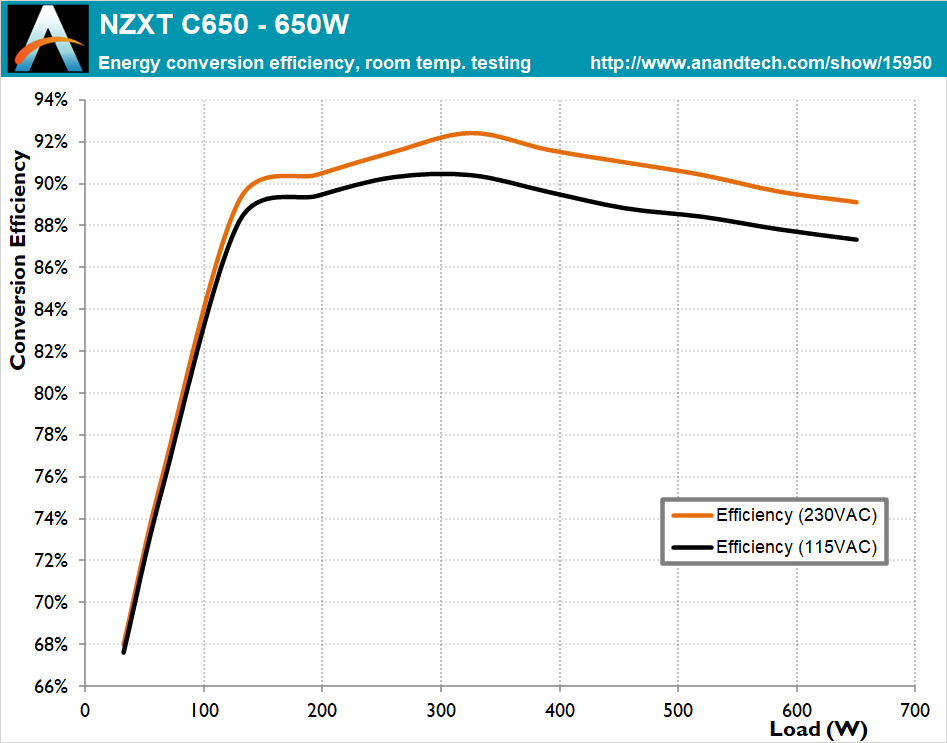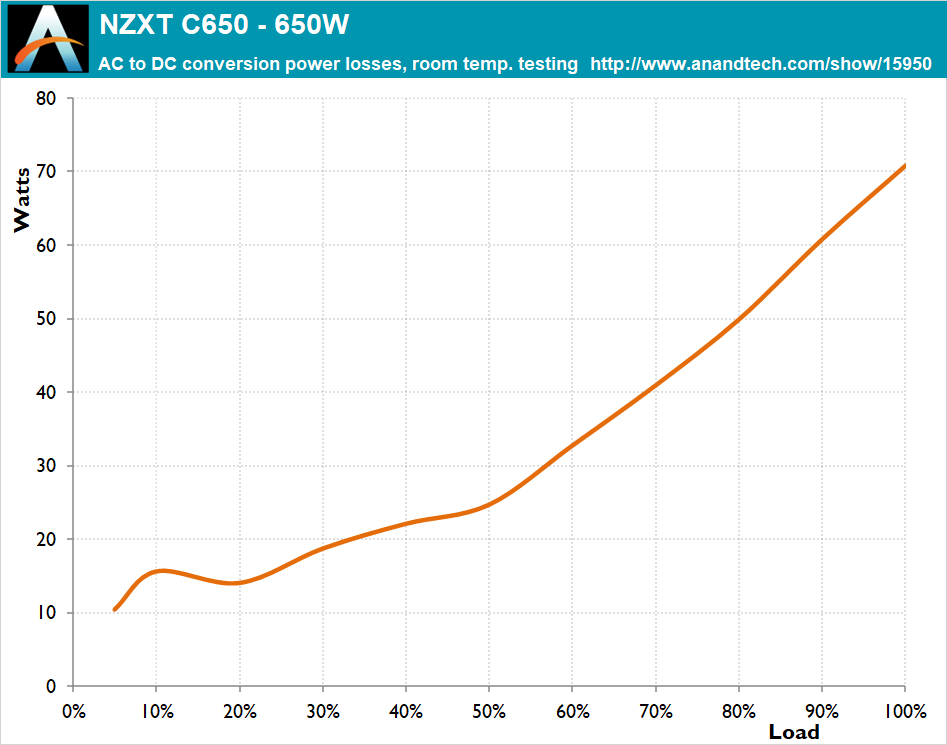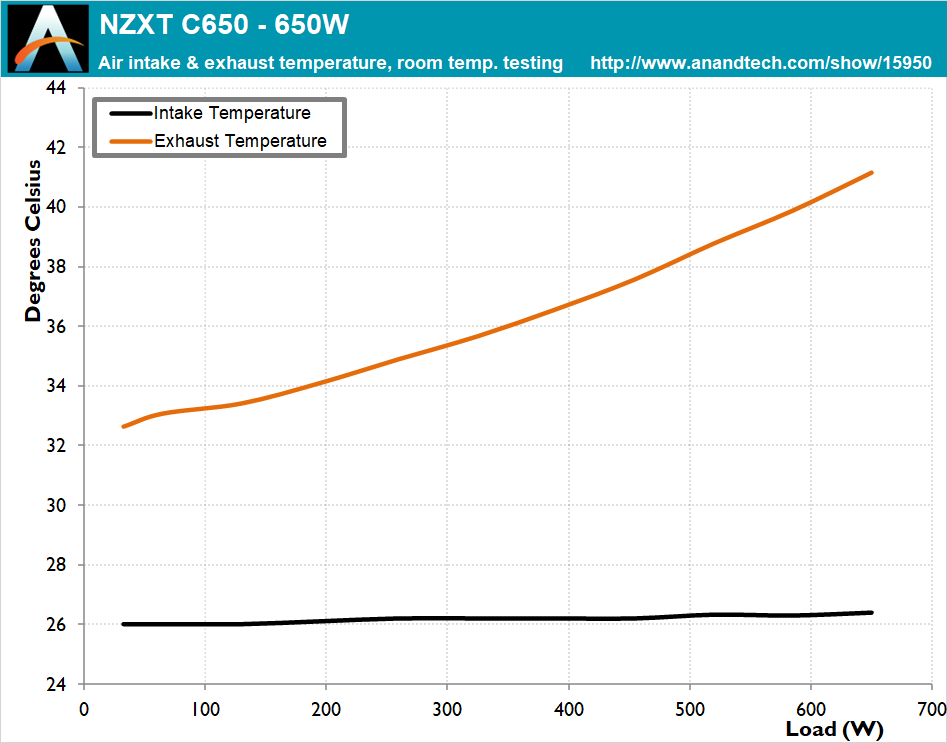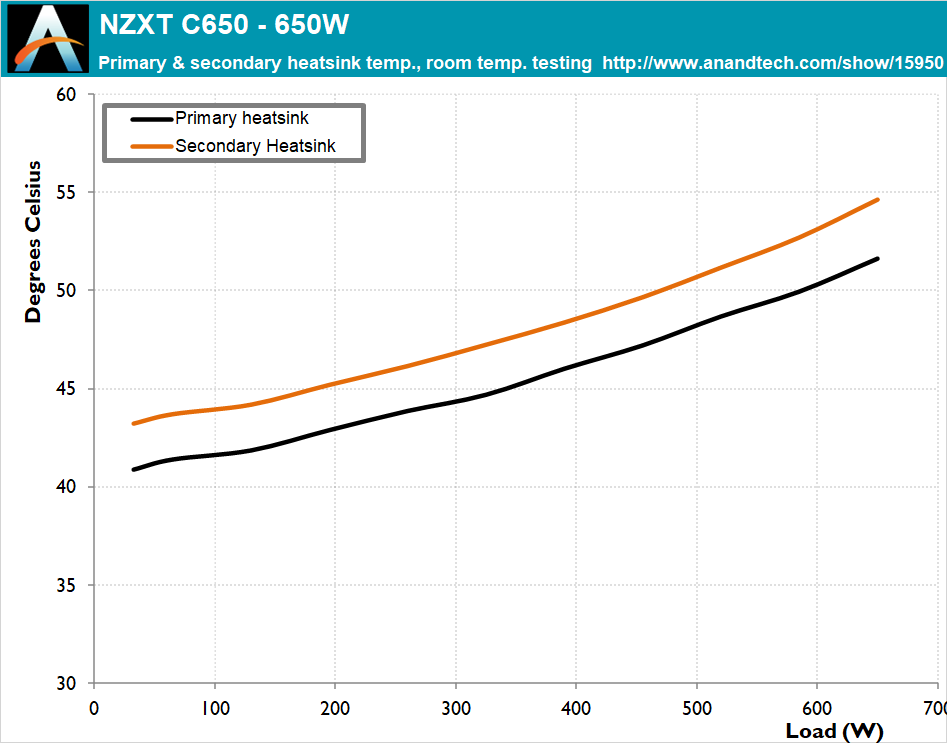The NZXT C650 650W PSU Review: Designed To Last
by E. Fylladitakis on August 11, 2020 8:00 AM EST- Posted in
- Cases/Cooling/PSUs
- PSUs
- 80Plus Gold
- NZXT
- 650W
- Modular
Cold Test Results
For the testing of PSUs, we are using high precision electronic loads with a maximum power draw of 2700 Watts, a Rigol DS5042M 40 MHz oscilloscope, an Extech 380803 power analyzer, two high precision UNI-T UT-325 digital thermometers, an Extech HD600 SPL meter, a self-designed hotbox and various other bits and parts. For a thorough explanation of our testing methodology and more details on our equipment, please refer to our How We Test PSUs - 2014 Pipeline post.
From the above charts, we can see that the NZXT C650 meets the 80Plus Gold certification requirements when powered from either a 230 VAC or 115 VAC outlet, even if only barely. It almost missed the certification requirements at 20% load and we can see that the efficiency of the PSU plummets as the load decreases, dropping well below 70% when the load is lower than 35 Watts. When the load drops below 20%, the efficiency drops so much that the raw power losses increase – a very rare effect. Apparently, this platform is not designed to cope with loads much lower than those intended.
We tested the NZXT C650 with its hybrid fan mode disabled, meaning that the fan was running at all times. In that scenario, the fan only became noticeable when the load ws greater than 320 Watts, and remained barely audible for loads up to 450 Watts. It eventually reached 42.9 dB(A) under maximum load, a passable noise figure for most users, and a great result from a PSU that is using a 120 mm fan. Considering that a PSU should never run at maximum load for prolonged periods of time, the NZXT C650 should be unnoticeable if installed inside a well-ventilated case.















34 Comments
View All Comments
YB1064 - Tuesday, August 11, 2020 - link
It would be interesting and minimal effort on your part to post a PSD (power spectral density) plot. You can use the ~$300 Red Pitaya (STEMLAB) as a spectrum analyzer (DC-60MHz+). This is useful additional information for those concerned about switching noise.If you are not familiar with the Re Pitaya, here it is:
https://www.redpitaya.com/f135/spectrum-analyzer
E.Fyll - Tuesday, August 11, 2020 - link
Perhaps PSD measurements would be academically interesting but do not affect anything that would actually concern the end-user of a PSU, with maybe the exception of identifying excessive phase noise that would be easily identifiable in the time domain and I would see it anyway. It also is excessively difficult to take a proper PSD measurement off a device with a switching power circuit, especially of non-discrete signals, and would mean nothing in the end because it would be impossible to identify what is actually causing any given noise. The only stage that taking PSD measurements of a PSU is during its development stage, to test for EMC compliance and to empirically tweak the platform (if necessary). Other than that, PSD is very useful in communications but not in power electronics.YB1064 - Wednesday, August 12, 2020 - link
Thank you for the clarification.rocketman122 - Tuesday, August 11, 2020 - link
nothing is durable and lasts here in the middle east. dust will break down anything and everything. horrible climate.hehatemeXX - Tuesday, August 11, 2020 - link
If they make a complete passive PSU, that does not get crazy hot, and has a rather large heatsink... maybe ;)Showtime - Tuesday, August 11, 2020 - link
Noctua, and other companies have fans that are sealed. Good ones should be able to deal to deal with dust, and heat just fine with some cleaning. Idk if it's your radiators that go bad, but I'd run a tower cooler since the fins are easy to clean. Go with the bigger coolers on your graphics card. The rest of it is dusting when needed. It's not as bad here in California, but we get those 100c days, but my Noctua cooler, and triple fan GPU handle it fine.GreenReaper - Wednesday, August 12, 2020 - link
100C days? Man, global warming is worse than I thought! :-DWe're getting 34C here and it's bad enough; but we lack A/C in UKia.
MrVibrato - Monday, August 17, 2020 - link
Days with 100C? Press F to pay thermic respects...Samus - Wednesday, August 12, 2020 - link
I used to live in San Diego and the salt in the air (I was a block from the ocean) would corrode the inside of PC's like acid. The solution was to go passive cooled on the secondary components and liquid cooled on the primary. I still had a fan inside the otherwise sealed case to distribute air and help the water blocks absorb ambient heat, and the case was always very warm (around 110F-120F under load, down to 80F at idle at a 70-75F ambient)The radiator 'tower' was external to the entire case, and since it was all aluminum and the fan bearings were sealed, never had a problem.
All of this was NOT cheap but it was cheaper than replacing every piece of steel or soldered component inside the case every few years.
Amoro - Tuesday, August 11, 2020 - link
The main downside to this PSU is the lack of a second 8-pin for the CPU. Most X570 motherboards seem to require an 8 and a 4 pin.